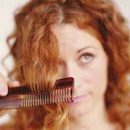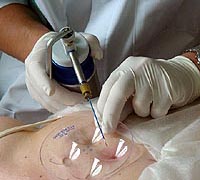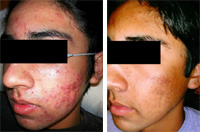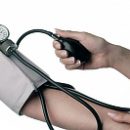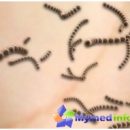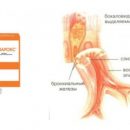The result of the injuries of the skin, operations, certain diseases and poor-quality cosmetic skin care are scarmers and scars. You can try to hide them under the clothes, depriving themselves the opportunity to wear open dresses or swimsuits.
Content
Scar skin lesions are a serious cosmetology problem. Scars are the inevitable consequence of any open injury or operation. Any wound healing is a complex biological process of connecting damaged tissues. The scar consists of connective tissue and contains a large amount of dense, elastic fibers. After the formation of the scar, its restructuring processes begin. Capillaries, lymphatic vessels grow into it, nerve endings germinate. It gradually decreases in volume, it becomes softer, acquires the color of surrounding tissues. The process of changing the scar is called its ripening, which completely ends in approximately one year after its formation. There are various types of scars - atrophic, hypertrophic and keloids, and in each of these groups, separate species differ in form.
Optimal
scarring
Arise as a result of a normal connecting tissue reaction on injury. These are flat scars of light color with normal or reduced sensitivity and close to normal tissue elasticity. Such scars are optimal.
Atrophic, or flat, scars are most often observed after burns, various diseases (Volchanka, syphilis, etc.). They are soft, low-lifting as a result of fiber atrophy under them. The skin of the scar is thinned, does not protrude on healthy skin, the surface is usually pigmented with depigmentation along the periphery. Sometimes flat atrophic scars are completely depigmented and have a brighter color than healthy skin. Often the surface of the scarpets at the expense of sclerosated capillaries acquires bright pink color. Arise as a result of a reduced reaction of the connective tissue on the injury. Collagen is not enough. Atrophic scars are located below the level of the surrounding skin. With a small width, almost no differ from the normatrophic scars.
Scars after burns
Appear more often after burns and surgical interventions. They often have the type of heavy skin on the skin in the form of rollers, or extensive arrays covered with skin folds; soft, movable, painless. On the face are located more often in the cheek area, near the nasolabial folds or around the mouth. Are a consequence of an excessive reaction of the connective tissue on the injury on the background of adverse healing conditions (inflammation, scar stretching). Fibroblasts with increased activity The excess amount of collagen is synthesized, its excess is not solved fully. Microscopy is visible to mature collagen and elastin fibers, forming nodes. Externally, the hypertrophic scar is protruding over the surface of the skin, slightly compacted litter (in the form of a rope), the width of which can vary. The size of the scar corresponds to the preceding skin injury. Hypertrophic scars are capable of smoothing after 1-1.5 years after injury, but not always completely.
Perverted scars
Develop as a consequence of a perverted tissue reaction to injury. As a rule, keloids are formed against the background of reduced indicators of general and tissue immunity. In the study of keloid tissue, extremely active fibroblasts are found, the degree of activity is 4 times higher than that of cells at a normal healing process. Collagen (mostly immature) is located in the form of wide loose beams and nodes, elastin is missing. Celoids have an elastic consistency, uneven, slightly wrinkled surface, significantly protrude above the skin surface. Sometimes the warts resemble their appearance. Keloid scars are constantly growing - then quickly, slowly, their growth can be accompanied by itching, burning and pain. As a result of the inexpressive growth, the volume of the visible part of the scar can exceed the volume of its intradermal part several times. Keloids are not capable of spontaneous regression. A typical example is the keloid scars formed after piercing the ear of the ear for wearing jewelry.
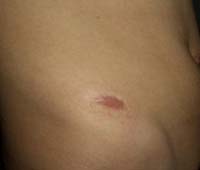 Extensive postoperative and post-traumatic scars are subject to skin-plastic correction. For the correction of small postoperative or post-traumatic scars, scars after transferred inflammatory skin diseases (acne) We successfully apply laser grinding with a scanning laser mode «Super Pulse» and Erbiyem laser.
Extensive postoperative and post-traumatic scars are subject to skin-plastic correction. For the correction of small postoperative or post-traumatic scars, scars after transferred inflammatory skin diseases (acne) We successfully apply laser grinding with a scanning laser mode «Super Pulse» and Erbiyem laser.
The combined application of lasers allows up to 3 microns to gently polish the surface of the scar, making them practically imperceptible. The procedure is performed under local anesthesia, quickly and practically beless. In the case of hypertrophic and kelide scars, laser grinding is complemented by special before and postoperative therapy. Erbium laser acts at the level of surface layers of the skin, producing evaporation of cells and coagulation of surrounding tissues. The laser beam destroys the anomalous scar cloth and stimulates the synthesis of new collagen and elastin in this place and in the surrounding tissues. In place of coarse, incorrectly formed fabric grows new. After several procedures, wide scars (for example, after adenectomy, cesarean section) are smoothed and become more aesthetically acceptable, and thin scars (for example, after plastic operations) almost completely disappear.
The use of radiation of a carbon dioxide laser for the treatment of scar changes is accompanied by a smaller number of complications than the acute excision of tissues, dermabrasion or chemical peeling. Laser skin grinding increases its elasticity, removes damaged layers, scars and scars that violate the appearance of a woman or a man. Such side effects of laser exposure as swelling, redness and reduction of sensitivity, quickly pass and do not have a significant impact on the final result.
The first effect of grinding the scar can be estimated after 1-2 weeks. But the finally the effect is visible not earlier than 3-6 months after the procedure. Re-laser grinding, if necessary, is held 6 months after the first.
Already a long time and successfully apply various techniques using a laser for removing and grinding scars. Do not delay, but to get the most complete information on issues related to the removal or grinding of scars, you only need to contact the specialists of our Center for the professional full-time consultation and approval of the plan and timing of your further treatment.


